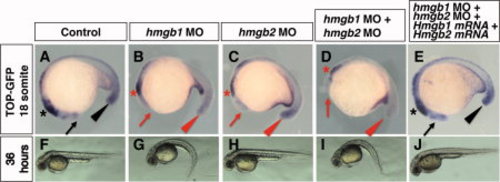|
hmgb1and hmgb2 are required for enhancement of Wnt/β-catenin signaling in zebrafish embryos. Lateral views of 18-somite-stage embryos (A–E) and 36-hpf embryos (F–J) injected with control MO (A, F), hmgb1 MO (B, G), hmgb2 MO (C, H), both hmgb1 MO and hmgb2 MO (D, I) and hmgb1 MO, hmgb2 MO, Hmgb1 mRNA, and Hmgb2 mRNA (E, J). A–E: Top-GFP expression is visualized by in situ hybridization. Wnt/β-catenin signaling in forebrain (arrows), midbrain (asterisks), and tail bud (arrowhead) is visualized in control morphants (A), but downregulated in hmgb-downregulated embryos (B–D). In mRNA co-injected double morphants, Top-GFP expression is partially restored (E). Normal body extension (F) is impaired in hmgb1-morphants (G). The phenotype is less severe in hmgb2-morphants (H), but becomes more severe in double morphants (I). This phenotype was partially restored by co-injection of Hmgb1 mRNA and Hmgb2 mRNA (J).
|

